 Di seguito le testimonianze sindoniche presenti nella Valle del Malone e nel Ciriacese.
Di seguito le testimonianze sindoniche presenti nella Valle del Malone e nel Ciriacese.
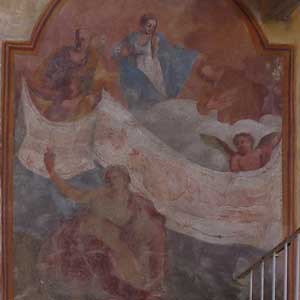
Corio
Piazza della Chiesa, affresco del XVIII secolo: due Angeli sorreggono la Sindone alla presenza della Madonna, San Giuseppe, San Francesco d’Assisi e Santa Chiara. In vicolo Gesù c’è un affresco con la scritta “per te peccatore agonizza e muore”.
In Church Square is a private house with a fresco dating XVII century: that shows the Mother of God, S. Giuseppe, S. Francesco d’Assisi, S. Chiara and two angels that support the Holy Shroud. In Vicolo Gesu’ a fresco shows Christ on the cross with the writing “for you sinner he agonises and dies”.
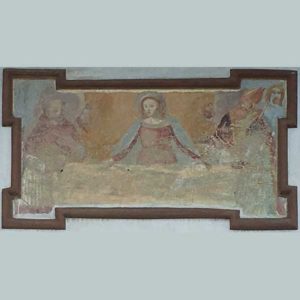 Rocca C.se
Rocca C.se
Affresco. La Madonna è in abito rosso e manto azzurro, San Carlo Borromeo con la cotta bianca ed il manto rosso, a destra San Grato con il pastorale.
A beautiful fresco, restored and framed in which the Mother of Jesus is in red dress and blue mantle, San Carlo Borromeo with the red mantle and on the right there is San Grato.
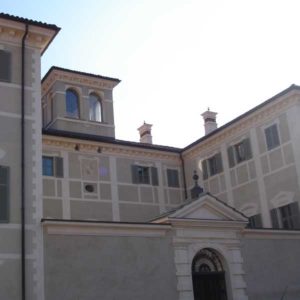 Grosso C.se
Grosso C.se
Cappella interna al castello, detta della Santa Sindone. Dipinto con la Madonna, San Giuseppe e San Giovanni Battista che sorreggono la Sindone. San Bernardino da Siena e Sant’Antonio da Padova mostrano la Reliquia.
The altar of the chapel is garnished with a very precious Bartolomeo Caravoglia painting which dates back to the Sixties or Seventies of the Seventeeth century. Here the Virgin Maria, San Giuseppe e San Giovanni Battista support the Holy Shroud. At the bottom San Bernardino da Siena and Sant’Antonio da Padova encourage to observe the relics.
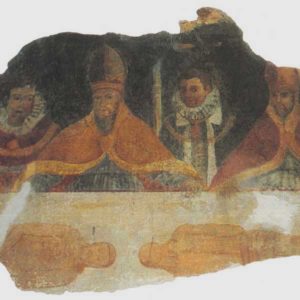 Nole C.se
Nole C.se
Cappella di San Grato. Affresco del XVI secolo. Alcuni Vescovi con mitria e manto porporato reggono la Sindone. Alle spalle, i Duchi Emanuele Filiberto di Savoia e Carlo Emanuele.
At the entrance of San Grato chapel, on the right, is a fresco from the XVI century showing some Bishops with purple mantle supporting the Holy Shroud. Casa Savoia’s Dukes Emanuele Filiberto and Carlo Emanuele are still well visible behind the Bishops.
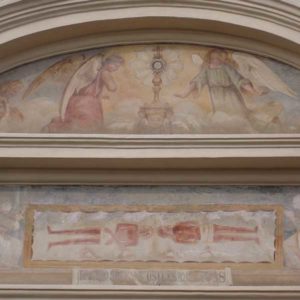 San Maurizio C.se
San Maurizio C.se
Chiesa parrocchiale. Affresco di G. Aimo. Sindone sorretta da due angeli. Non lontano dalla chiesa, all’angolo tra via Cavour e via Bertone c’è un affresco del XVIII sec. in cui la Sindone è sorretta da due angeli, sulla sinistra un Papa che indica il Lino. Sull’altro lato, la Vergine con una corona di stelle.
Above the entrance door of the church, there is a fresco. Not far from the church, in the corner between via Cavour and via Bertone, on a private house you can still see a fresco from the XVII century in which the Holy Shroud is supported by two angels and San Maurizio and the river are painted. On the left a Pope, maybe Pio known for the Lepanto battle, who points the shroud with the left hand. On the other side of the corner the Virgin queen is painted with a stat crown.
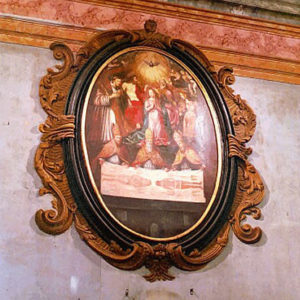 Ciriè
Ciriè
Chiesa di San Martino: Deposizione. Chiesa del Santo Sudario: affreschi nell’abside, sotto la tribuna del palco dell’orchestra, nel palliotto dell’altare, sopra l’organo e sulla facciata. Su una casa privata, all’angolo tra via Matteotti e via Costa c’è un affresco con la Deposizione.
San Martino church: Deposition. Holy Shroud Church: frescos in the absis, below the orchestra stage, in the main altar and above the organ. The fresco on a private building in the corner between Via Matteotti and Via Costa shows the laying of Jesus from the cross.
 FIANO. Inserito in un trittico sulla facciata della cappella di Sant’Anna, sopra la porta d’ingresso, l’affresco del XVI secolo con la Sindone distesa riporta i segni delle bruciature causate dall’incendio del 1532 a Chambery. la Sindone è sorretta da due angeli ai lati di un Vescovo in atto di venerazione, con manto e tiara. In origine l’affresco riportava la Madonna al centro. Fu il pittore Giacomo Castrale a sostituire, durante il restauro, la Madonna con il Vescovo. Gli affreschi datati anteriormente il XVII secolo riportano santi e Vescovi con la Sindone, mentre solo dopo il 1700 circa compare la Vergine.
FIANO. Inserito in un trittico sulla facciata della cappella di Sant’Anna, sopra la porta d’ingresso, l’affresco del XVI secolo con la Sindone distesa riporta i segni delle bruciature causate dall’incendio del 1532 a Chambery. la Sindone è sorretta da due angeli ai lati di un Vescovo in atto di venerazione, con manto e tiara. In origine l’affresco riportava la Madonna al centro. Fu il pittore Giacomo Castrale a sostituire, durante il restauro, la Madonna con il Vescovo. Gli affreschi datati anteriormente il XVII secolo riportano santi e Vescovi con la Sindone, mentre solo dopo il 1700 circa compare la Vergine.
Fiano. Inserted in a trypthic on the facade of Sant’Anna chapel, above the entrance door, the fresco from the XVI century with the lying shroud shows the signs of the 1532 fire in Chambery. The shroud is supported by two angels and one bishop venerating it. Originally the fresco showed the Virgin Queen in the centre but the painter Giacomo Castrale substituted, during the restoration, the Virgin Queen with the bishop. The frescos painted before the XVII century report saints and bishops with the shroud while just after the 1700 the Virgin Queen appears.
